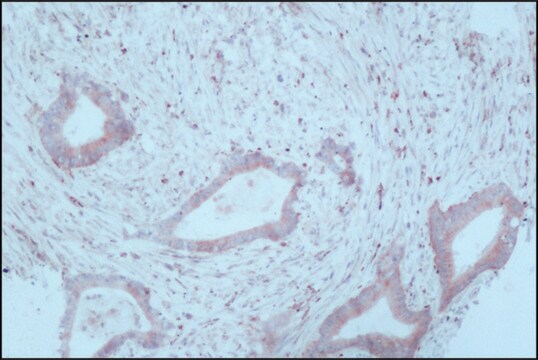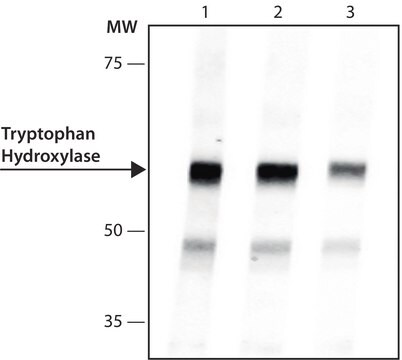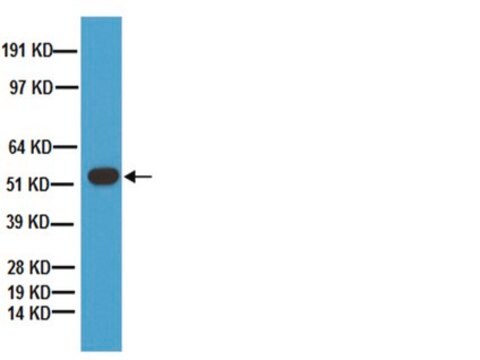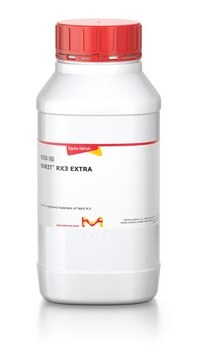SAB4700188
Monoclonal Anti-CD44 antibody produced in rat
clone IM7, purified immunoglobulin, buffered aqueous solution
Sinónimos:
Anti-Pgp-1
Iniciar sesiónpara Ver la Fijación de precios por contrato y de la organización
About This Item
UNSPSC Code:
12352203
NACRES:
NA.41
Productos recomendados
biological source
rat
conjugate
unconjugated
antibody form
purified immunoglobulin
antibody product type
primary antibodies
clone
IM7, monoclonal
form
buffered aqueous solution
species reactivity
mouse, horse, canine, human, feline
concentration
1 mg/mL
technique(s)
flow cytometry: suitable
isotype
IgG2b
NCBI accession no.
UniProt accession no.
shipped in
wet ice
storage temp.
2-8°C
target post-translational modification
unmodified
Gene Information
human ... CD44(960)
General description
The CD44 (cell-surface glycoprotein) gene with 20 exons is mapped to human chromosome 11p13. The gene codes for a transmembrane glycoprotein.
The rat monoclonal antibody IM7 reacts with CD44 antigen (Phagocyte glycoprotein 1), an 80-95 kDa transmembrane glycoprotein (hyaladherin family) present on the most of cells and tissues (leukocytes, endothelial cells, mesenchymal cells, etc.); it is negative on platelets and hepatocytes. The antibody reacts with all isoforms of mouse CD44.
Immunogen
Dexamethasone-induced cells of the SJL mouse spontaneous myeloid leukemia M1
Application
Monoclonal Anti-CD44 antibody produced in rat has been used in immunohistochemistry.
The reagent is designed for Flow Cytometry analysis. Suggested working dilution is 1 μg/mL of sample. Indicated dilution is recommended starting point for use of this product. Working concentrations should be determined by the investigator.
Biochem/physiol Actions
CD44 (cell-surface glycoprotein) is involved in cell-cell and cell-extracellular matrix interactions. It plays an important role in lymphocyte homing and lymphocyte activation. It also acts as a metastasis suppressor gene for prostatic cancer. Overexpression of CD44 leads to esophageal squamous cell carcinoma (ESCC). CD44 inhibits macrophage multinucleation by interacting with its ligands, hyaluronic acid, chondroitin sulfates and osteopontin. 100kDa form of CD44, facilitates the binding of poliovirus to HeLa cells. In addition, it also implicated in the infection of mononuclear phagocytes by human immunodeficiency virus (HIV).
Features and Benefits
Evaluate our antibodies with complete peace of mind. If the antibody does not perform in your application, we will issue a full credit or replacement antibody. Learn more.
Physical form
Solution in phosphate buffered saline, pH 7.4, with 15 mM sodium azide.
Disclaimer
Unless otherwise stated in our catalog or other company documentation accompanying the product(s), our products are intended for research use only and are not to be used for any other purpose, which includes but is not limited to, unauthorized commercial uses, in vitro diagnostic uses, ex vivo or in vivo therapeutic uses or any type of consumption or application to humans or animals.
¿No encuentra el producto adecuado?
Pruebe nuestro Herramienta de selección de productos.
Storage Class
10 - Combustible liquids
flash_point_f
Not applicable
flash_point_c
Not applicable
Elija entre una de las versiones más recientes:
¿Ya tiene este producto?
Encuentre la documentación para los productos que ha comprado recientemente en la Biblioteca de documentos.
A rare missense variant in RCL1 segregates with depression in extended families
Amin N
Molecular Psychiatry (2017)
Heli Li et al.
Journal of immunology research, 2018, 4807145-4807145 (2019-01-24)
The immunologic interaction between parenchyma cells and encircling inflammatory cells is thought to be the most important mechanism of biliary damage and repair in primary sclerosing cholangitis (PSC). Monocytes/macrophages as master regulators of hepatic inflammation have been demonstrated to contribute
CD44 occupancy prevents macrophage multinucleation.
Sterling H
The Journal of Cell Biology, 143, 837-847 (1998)
Autophagy supports generation of cells with high CD44 expression via modulation of oxidative stress and Parkin-mediated mitochondrial clearance
Whelan KA
Oncogene, 36, 4843-4858 (2017)
Gongcai Qiu et al.
International journal of oncology, 55(1), 45-58 (2019-05-07)
The present study aimed to explore the long non‑coding RNA (lncRNA) expression profiles and correlation of lnc‑PKD2‑2‑3 with tumor features and prognosis, and to investigate its effect on regulating cancer‑cell stemness and its potential as a cancer stem cell (CSC) marker
Nuestro equipo de científicos tiene experiencia en todas las áreas de investigación: Ciencias de la vida, Ciencia de los materiales, Síntesis química, Cromatografía, Analítica y muchas otras.
Póngase en contacto con el Servicio técnico







